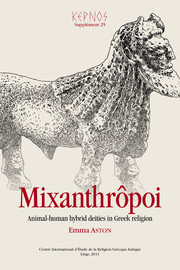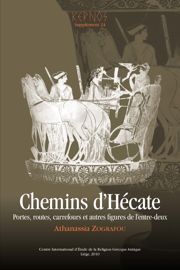Newly Online Kernos suppléments
Mixanthrôpoi: Animal-human hybrid deities in Greek religion
…Many of the beings in this book – Cheiron, Pan, Acheloos, the Sirens and others – will be familiar from the narratives of Greek mythology, in which fabulous anatomies abound. However, they have never previously been studied together from a religious perspective, as recipients of cult and as members of the ancient pantheon. This book is the first major treatment of the use of part-animal – mixanthropic – form in the representation and visual imagination of Greek gods and goddesses...
Section One : Cults and composition of mixanthropic deities
Chapter I
Deities of the sea and riversChapter II
Terrestrial mixanthropesChapter III
Winged and horned godsSection Two : Movement, absence and loss
Chapter VI
The fallacy of ArcadiaSection Three : Mixanthropy and representation
Chapter VII
Mixanthropy and metamorphosisChapter IX
Mixanthropy and pluralityChapter X
Gods, monsters and imagery
Chemins d'Hécate: Portes, routes, carrefours et autres figures de l'entre-deux
…Hécate est une figure divine qui a longtemps été reléguée dans le monde d’en bas, dans l’univers de la superstition et de la magie. Les approches classiques n’ont guère rendu justice au rapport que la déesse entretient à l’espace, par sa présence aux portes, aux carrefours et aux divers autres points de passage. C’est une exploration attentive aux réalités concrètes, voire triviales, qu’offrent les analyses de ces Chemins d’Hécate, où la déesse fonctionne comme une sorte d’opérateur...
Hécate dans la poésie archaïque
L'espace et le temps d'Hécate
Tributs, attributs et attitudes

